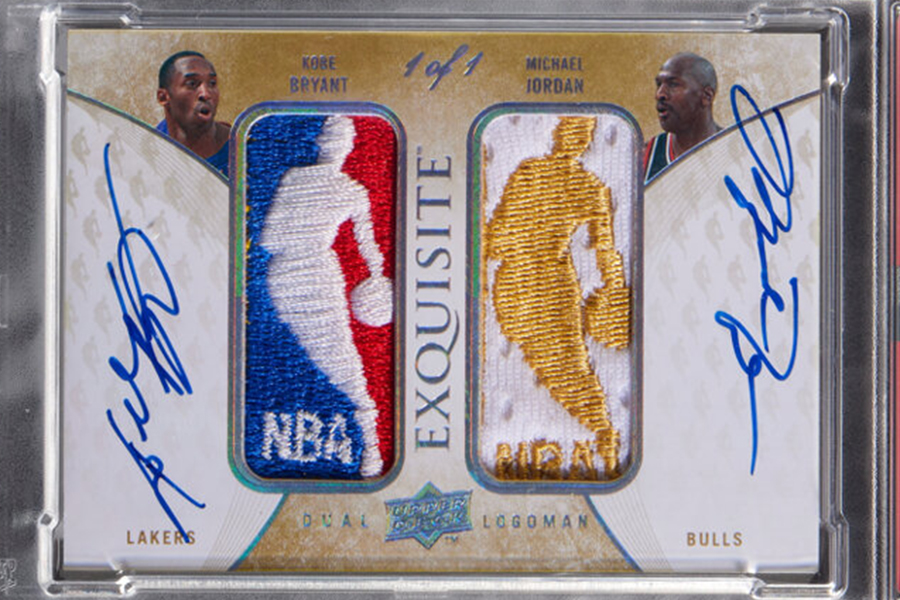You might think that a pitch seeking investment in the most expensive sports card ever sold would be laughed out of the room on Shark Tank, especially at a valuation of $12.9 million. In my own experience as a family office professional, I’ve long extolled the rising financial might of collections, only to be met with more than my fair share of bemused looks.
But Kevin O’Leary, the renowned investor and entrepreneur, met the proposition not with laughter but with the rigorous diligence applied in traditional investments and an eagerness to secure one of the top assets in an emerging asset class.
In late August, bidding reached record levels at Heritage Auctions for a rare sports card featuring autographs and game-worn jersey patches from sporting icons Michael Jordan and Kobe Bryant. Industry observers expected the card to become the most expensive basketball card in history. But at its sale price of $12.9 million, the card also soared past the likes of Mickey Mantle and Honus Wagner to claim the title of the most expensive trading card ever sold.
That status raises eyebrows among astounded hobby outsiders and incredulous faithful collectors alike, as those mere patches from jerseys, encased in cardboard, commanded more money than any full Michael Jordan or Kobe Bryant game-worn jersey ever has. Critics of the card — and cards like it — might describe its scarcity as artificial, resulting from the decisions of a manufacturer rather than the passage of time or irreplicable association with a significant moment. But that’s not necessarily a detriment to value, as evidenced by the bidding war among the card’s adoring fans that pushed it to record levels.
A day after the auction hammer dropped to seal the momentous occasion, O’Leary took to CNBC to reveal that he was part of a syndicate that emerged victorious in bidding, joining two other collectors in the effort. His rationale for the purchase echoes our own long-held view that collectibles merit consideration not just as a passion pursuit but as an asset class.
“I’ve been looking at this asset class now for three years. It’s an extraordinary return,” O’Leary shared with CNBC. “I’ve looked at the research in contemporary art and modern art. The majority of capital gains accrue to the rarest Pollocks or Warhols. Pieces that are extraordinarily priced, you think. And then you wait a decade and look at them again, and you get extraordinary capital gains. It’s a very thin market, but as an alternative asset class, I’m all in.”
Indeed, O’Leary’s group again demonstrated its seriousness in October, reportedly paying $10 million in a private sale for a card bearing autographs and Logoman patches from Michael Jordan and LeBron James. That card became the third most expensive ever sold, and it’s only one of many they’ve added to their stable.

His assertions lend credibility to trends we’ve observed with greater frequency in recent years. While the Jordan-Bryant card is a record-setter, it’s only the latest in a growing line of top-tier collectibles selling for prices previously seen only in fine art. Take, for instance, Babe Ruth’s “Called Shot” jersey, which sold for a record $24.1 million last summer. Over the course of nearly two decades since a $940,000 sale in 2005, it appreciated at a rate of 18% annually, albeit aided by improved authentication.
Rising values aren’t limited to the grails of sports memorabilia. In 2024, a Victor Edelstein evening dress previously owned by Princess Diana sold for $910,000 at Julien’s Auctions. That same dress sold at a Christie’s charity auction in 1997 for a mere $25,300; it increased in value by 14% annually. Similarly, Jane Birkin’s “Original Birkin” reinforced the appeal of cultural artifacts when it reached a $10 million sale price at Sotheby’s in July.
On CNBC, O’Leary likened his new acquisition in the sports collectibles market to one that’s more broadly understood and accepted: watches. “It’s no different than collectible watches, [like] an F.P. Journe, which I’m wearing on my wrist. It reminds me of that market. It’s so rare that the prices continue to appreciate, and they seem to defy recessions.”
At the top of each collecting category, a broadening set of buyers is chasing a small subset of assets that offer a tantalizing confluence of rarity and cultural significance, pushing values to heights previously unfathomable. That track record has attracted participation from the likes of O’Leary and other investment-minded parties who see not only museum-grade artifacts but potentially differentiated sources of return.
Where investment-minded entrants go, fund activity often follows. O’Leary mentioned to Fox Business that he has spoken to banks about exploring ways of offering ownership in the syndicate’s portfolio, dubbed the “Wondershyne Index,” to collectors. Whether it’s that syndicate or another group, the ability to successfully offer an investible product would invite increased competition, resulting in more dollars chasing top-tier assets.
The heightened demand is life-changing news for longtime collectors who secured these fabled assets at lower prices in decades past. The sharp appreciation in value means that their collections are now seven or eight-figure windfalls and represent an increasingly significant portion of their balance sheets. As allocations to collectible assets grow, even passively, considering their financial impact becomes crucial.
Unfortunately, not all collectors pursue a rigorous approach to collection-related financial planning. Because their acquisition was motivated more by passion and less by monetary gain, many collectors tend to silo their collections from the rest of their assets. But this inclination can lead to suboptimal outcomes.
There are the investment risks to consider: overconcentration, volatility and drawdown potential, and the often spotty liquidity of collectible markets. These factors are of paramount concern to investment-minded entrants, and they likely warrant acute attention at present, with some prices appearing frothy. While he’s unconcerned with near-term fluctuations in value, O’Leary offered commentary on his approach to the asset class.
“I don’t think [the Jordan and Bryant card] will come to market during my lifetime. It’s going to be a part of an index that I’m going to continue to grow along with my partners,” O’Leary explained. “We look at it no differently than our Bitcoin holdings, our Ethereum holdings, our gold holdings. For me, this is going to be a 5% weighting in my portfolio, maybe more. I don’t see it any differently than any of those other asset classes. However, it’s a lot more fun.”
But for long-time collectors who haven’t viewed their collections through a financial lens, there are simpler considerations to address as well.
For instance, is the collection appropriately valued and insured to protect against disaster? Are the assets authenticated properly to ensure their future marketability? Are heirs aware of the collection, and is there a plan in place to facilitate the collection’s transition in the event of death or incapacitation?
As a lifelong collector of sports memorabilia, I confronted the most troubling question of all years ago: would my family have any idea what to do with my collection if I passed tomorrow? That question prompted me to refine my collection-related organization and planning, and I continue to share those best practices to assist others with their journeys, however reluctant they are to begin them.
Perhaps at one point, a collection wasn’t worth enough for such questions to incite material concern. However, the headline prices achieved by top-tier items mean that collectors who own items of similar stature can ill afford to continue ignoring them. Whether collectors are eager to pursue returns or steward their collections with discipline, the process starts with thorough accounting and documentation of a collection’s contents.
Though that task daunts, high-net-worth collectors should not shy from consulting with and involving qualified financial professionals who can shoulder that burden. In an environment where rare items are selling for eight-figure prices, it’s paramount that advisors consider a client’s entire financial situation – collections included – to ensure a thoughtful and holistic approach to planning.
Kevin O’Leary is not the first notable professional investor to recognize collectibles’ status as an alternative asset class, and he won’t be the last. Other investment-minded participants – institutional and individual – will follow, perhaps even as a result of his statement acquisition, though he noted that this institutionalization is already underway.
The record $12.9 million price and the ensuing declarations from its new owner issue a loud reminder to the existing collector class: enjoy your hobby, but treat your trove as the asset class that it is.




